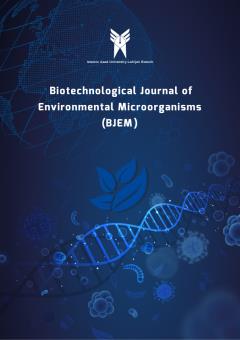Innovative Approaches to In-Silico Vaccine Design Against Dengue Virus Type 2
Subject Areas : Biotechnological Journal of Environmental MicrobiologyMahdieh SobhZahedi 1 , Mohammad Hossein YektaKooshali 2 , Hojjatola Zamani 3
1 - Department of Biology, Faculty of Basic Sciences, University of Guilan, Rasht, Iran
2 - Medical Biotechnology Research Center, School of Paramedicine, Guilan University of Medical Sciences, Rasht, Iran.
3 - Department of Biology, Faculty of Basic Sciences, Guilan University, Rasht, Iran
Keywords: Dengue virus type 2, vaccine design, multiepitope vaccine, immunoinformatics,
Abstract :
Introduction: Dengue virus type 2 (DENV-2) poses a continuous and growing public health challenge. This study aimed to develop a vaccine candidate with the potential to effectively DENV-2, utilizing bioinformatics servers for the design process.
Methods: A multi-faceted in silico approach to design a novel vaccine against DENV-2, focusing on the identification of immunogenic epitopes crucial for eliciting robust immune responses was utilized. The viral genome was analyzed to identify effective epitopes. Candidates' epitopes for vaccine design were selected based on their characteristics, such as being non-toxic, non-allergenic, and possessing high immunogenicity. Subsequently, the predicted epitopes were joined with adjuvants, linkers, and a his-tag to formulate the vaccine construct. Following this, a comprehensive evaluation of the vaccine was conducted.
Results: After the investigations, a non-toxic, non-allergenic protein with an antigenic score of 0.7776 was selected as a candidate for vaccine design. 4 epitopes for B cells and 19 epitopes for T cells were predicted, and the vaccine candidate was completed by combining these epitopes. The vaccine structure was predicted to be non-toxic, non-allergenic, and had a favorable immunogenicity score of 0.7044. Furthermore, the designed vaccine successfully passed all virtual assessments, which encompassed the analysis of its physical and chemical properties, as well as evaluations of its secondary and tertiary structures.
Conclusion: Based on the results, this multi-epitope peptide can be used as a promising vaccine candidate that warrants further development. Ultimately, this study makes a significant contribution to the overarching aim of controlling and preventing dengue fever, opening avenues for innovative vaccine strategies that could substantially lessen the global impact of this disease. Additional research is necessary to evaluate the functional characteristics, conduct in vitro and in vivo experiments, explore potential applications, and perform animal model studies to validate the safety, efficacy, and long-term effects of the vaccine formulation.
1. Sukupolvi-Petty, S., et al., Structure and function analysis of therapeutic monoclonal antibodies against dengue virus type 2. Journal of virology, 2010. 84(18): p. 9227-9239.
2. Zandi, K., et al., Antiviral activity of four types of bioflavonoid against dengue virus type-2. Virology journal, 2011. 8: p. 1-11.
3. Sirisena, P., et al., Concurrent dengue infections: Epidemiology & clinical implications. Indian Journal of Medical Research, 2021. 154(5): p. 669-679.
4. Guzman, M.G., et al., Dengue infection. Nature reviews Disease primers, 2016. 2(1): p. 1-25.
5. Guzman, M.G. and E. Harris, Dengue. The Lancet, 2015. 385(9966): p. 453-465.
6. Deng, S.-Q., et al., A review on dengue vaccine development. Vaccines, 2020. 8(1): p. 63.
7. Sridhar, S., et al., Effect of dengue serostatus on dengue vaccine safety and efficacy. New England Journal of Medicine, 2018. 379(4): p. 327-340.
8. Fadaka, A.O., et al., Immunoinformatics design of a novel epitope-based vaccine candidate against dengue virus. Scientific reports, 2021. 11(1): p. 19707.
9. Ali, M., et al., Exploring dengue genome to construct a multi-epitope based subunit vaccine by utilizing immunoinformatics approach to battle against dengue infection. Scientific reports, 2017. 7(1): p. 9232.
10. Fahimi, H., M. Sadeghizadeh, and M. Mohammadipour, In silico analysis of an envelope domain III-based multivalent fusion protein as a potential dengue vaccine candidate. Clinical and Experimental Vaccine Research, 2016. 5(1): p. 41-49.
11. Rombel, I.T., et al., ORF-FINDER: a vector for high-throughput gene identification. Gene, 2002. 282(1-2): p. 33-41.
12. Xiao, X., Z.-C. Wu, and K.-C. Chou, iLoc-Virus: A multi-label learning classifier for identifying the subcellular localization of virus proteins with both single and multiple sites. Journal of theoretical biology, 2011. 284(1): p. 42-51.
13. Petersen, T.N., et al., SignalP 4.0: discriminating signal peptides from transmembrane regions. Nature methods, 2011. 8(10): p. 785-786.
14. Käll, L., A. Krogh, and E.L. Sonnhammer, Advantages of combined transmembrane topology and signal peptide prediction—the Phobius web server. Nucleic acids research, 2007. 35(suppl_2): p. W429-W432.
15. Zaharieva, N., et al., Immunogenicity prediction by VaxiJen: a ten year overview. J. Proteom. Bioinform, 2017. 10(11): p. 10.4172.
16. Nasar, S., Z. Nasar, and S. Iftikhar, A novel strategy for developing a tetravalent vaccine (dvac) against dengue utilizing conserved regions from all DENV proteins. Microbial Pathogenesis, 2022. 164: p. 105447.
17. Vita, R., et al., The immune epitope database (IEDB) 3.0. Nucleic acids research, 2015. 43(D1): p. D405-D412.
18. Gupta, S., et al., In silico approach for predicting toxicity of peptides and proteins. PloS one, 2013. 8(9): p. e73957.
19. Garg, V.K., et al., MFPPI–multi FASTA ProtParam interface. Bioinformation, 2016. 12(2): p. 74.
20. Roohparvar Basmenj, E., et al., A novel approach to design a multiepitope peptide as a vaccine candidate for Bordetella pertussis. Journal of Biomolecular Structure and Dynamics, 2023: p. 1-13.
21. Kelley, L.A. and M.J. Sternberg, Protein structure prediction on the Web: a case study using the Phyre server. Nature protocols, 2009. 4(3): p. 363-371.
22. Davis, I.W., et al., MolProbity: all-atom contacts and structure validation for proteins and nucleic acids. Nucleic acids research, 2007. 35(suppl_2): p. W375-W383.
23. Yan, Y., et al., The HDOCK server for integrated protein–protein docking. Nature protocols, 2020. 15(5): p. 1829-1852.
24. Yenamandra, S.P., et al., Evolution, heterogeneity and global dispersal of cosmopolitan genotype of Dengue virus type 2. Scientific Reports, 2021. 11(1): p. 13496.
25. Roy, S.K. and S. Bhattacharjee, Dengue virus: epidemiology, biology, and disease aetiology. Canadian journal of microbiology, 2021. 67(10): p. 687-702.
26. Prompetchara, E., et al., Dengue vaccine: Global development update. Asian Pac J Allergy Immunol, 2020. 38(3): p. 178-185.
27. Martinelli, D.D., In silico vaccine design: A tutorial in immunoinformatics. Healthcare Analytics, 2022. 2: p. 100044.


